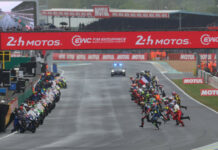800cc – DEJA VU There may be still another complete season to wait but already that feeling of deja vu is upon us as we contemplate another era in the short but eventful history of MotoGP, the arrival of the 800cc machine in 2007. It takes us back four years when the imminent journey into the unknown was the talk of the sport. The 500cc two-strokes were about to be replaced by the 990cc four-strokes and nobody honestly knew what to expect. Will the new machines lap as fast, will they be safer, how about fuel consumption, how many cylinders and how much will they cost to build and run were just a few of the unknowns. Four years on as those very same questions are being asked and once again, opinions are equally divided. The 800cc capacity has been introduced very much with safety in mind. Top speeds of over 310 km/h are commonplace when the 990cc machines face a straight of the adequate length. This was considered too fast on a regular basis and so the reduction in capacity by almost 200cc will be introduced in 2007 but will it reduce lap speeds. History in other motorsports suggest not for long. Technology and unfortunately more money will make up for the loss of capacity. The engineers and designers will get over the problem as long as they have the money to do it but how long will it take to be matching the lap times of the 990cc machines. “Every year lap records are being smashed and it will be very interesting to see just how long it takes the new 800cc machines to continue the trend,” said Sito Pons, the Team Principle of the Camel Honda team, who supervised the successful switch from two-stroke to four-stroke of his team in 2003. “As in 2003, we will only really know what to expect when we race the new machines for the first time where we raced the 990cc machine the previous year.” However Pons has more than a sneaking suspicion that laps records will not remain intact very long. “Clearly the introduction of the new capacity is to reduce the power of the bike for safety reasons but I think at the end of the day the engineers will get them producing the same power as the 900cc machines we are racing at the moment,” he explained. “It’s a big new step in the Championship and it will be a tremendous new project for the engineers to design a new combination of two, three, four or five cylinder machines with less weight.” Safety fears about the 990cc four-strokes proved unfounded with less accidents in the last three years than in the two-stroke dominated days. That trend should hopefully continue with the new regulations. “My personal opinion is when we changed to the four-strokes that the safety actually increased for our riders,” said Pons. “If you check the statistics there have been less crashes with the four-strokes than the two-strokes. The four-strokes are easier to control and more predictable although of course they are faster. We have already made one step ahead with the changes three years ago and if we go one step further by reducing the the capacity by almost 200cc, that’s got to be good for everybody.” So it appears most people think the new capacity will be good for safety, the engineers will have a field day and the racing should be as fast and furious as ever but what about the cost. Will it be more expensive to design build and race the new breed of MotoGP machines? “I would like to think that it would help in reducing the cost of the machines but I don’t think we can achieve this, ” admitted Pons. “It’s always difficult to prevent the costs soaring when you are exploring new technology. Every time you want to win you have to spend more money and everybody wants to win. The only limit to this spending is the money that you have available.” With costs soaring every season, more and more teams are feeling the pinch as MotoGP continues to explode across the World. Keeping those costs down to an acceptable level is an important component to the future success of the Championship as is the reduction in the engine capacity. “Only when we start testing the new machines will we know if we can reduce or at least maintain the costs,” revealed Pons, the former double 250cc World Champion. “It’s vital to the future of our Championship that we keep costs down because more inflation just makes it tougher for our partners, sponsors, manufacturers and teams.” Same questions and same problems as MotoGP prepares to march into yet another new era.
Team Owner Pons Does Not Think MotoGP Going To 800cc In 2007 Will Reduce Speeds Or Cost
Team Owner Pons Does Not Think MotoGP Going To 800cc In 2007 Will Reduce Speeds Or Cost
© 2005, Roadracing World Publishing, Inc.






